Design and Evaluation of a Flexible Dual-Band Meander Line Monopole Antenna for On- and Off-Body Healthcare Applications
Abstract
1. Introduction
2. Antenna Design
2.1. Proposed Topology and Approach
2.2. Proposed Design Strategy
2.3. Radiation Modes
2.4. Optimization for On-Body Communication
3. Measurement Results
3.1. Reflection Coefficient (S11) and Bandwidth
3.2. Radiation Patterns
3.3. Specific Absorption Rate (SAR)
4. Free-Space and On-Body Link Budget
4.1. Measurement Setup and Procedure
4.2. Free-Space Communication
4.3. On- and Off-Body Communications
5. Conclusions and Future Directions
Author Contributions
Funding
Conflicts of Interest
References
- Ali, S.M.; Sovuthy, C.; Imran, M.A.; Socheatra, S.; Abbasi, Q.H.; Abidin, Z.Z. Recent Advances of Wearable Antennas in Materials, Fabrication Methods, Designs, and Their Applications: State-of-the-Art. Micromachines 2020, 11, 888. [Google Scholar] [CrossRef] [PubMed]
- Cotton, S.L.; D’Errico, R.; Oestges, C. A review of radio channel models for body centric communications. Radio Sci. 2014, 49, 371–388. [Google Scholar] [CrossRef]
- Wagih, M.; Cetinkaya, O.; Zaghari, B.; Weddell, A.S.; Beeby, S. Real-World Performance of Sub-1 GHz and 2.4 GHz Textile Antennas for RF-Powered Body Area Networks. IEEE Access 2020, 8, 133746–133756. [Google Scholar] [CrossRef]
- Nepa, P.; Rogier, H. Wearable Antennas for Off-Body Radio Links at VHF and UHF Bands: Challenges, the state of the art, and future trends below 1 GHz. IEEE Antennas Propag. Mag. 2015, 57, 30–52. [Google Scholar] [CrossRef]
- Islam, A.; Kiourti, A.; Volakis, J.L. A Novel Method of Deep Tissue Biomedical Imaging Using a Wearable Sensor. IEEE Sens. J. 2015, 16, 265–270. [Google Scholar] [CrossRef]
- Casula, G.A.; Montisci, G. A Design Rule to Reduce the Human Body Effect on Wearable PIFA Antennas. Electronics 2019, 8, 244. [Google Scholar] [CrossRef]
- Dilmaghani, R.S.; Bobarshad, H.; Ghavami, M.; Choobkar, S.; Wolfe, C. Wireless Sensor Networks for Monitoring Physiological Signals of Multiple Patients. IEEE Trans. Biomed. Circuits Syst. 2011, 5, 347–356. [Google Scholar] [CrossRef] [PubMed]
- Alemaryeen, A.; Noghanian, S. On-Body Low-Profile Textile Antenna With Artificial Magnetic Conductor. IEEE Trans. Antennas Propag. 2019, 67, 3649–3656. [Google Scholar] [CrossRef]
- Boyes, S.J.; Soh, P.J.; Huang, Y.; VandenBosch, G.A.E.; Khiabani, N. Measurement and Performance of Textile Antenna Efficiency on a Human Body in a Reverberation Chamber. IEEE Trans. Antennas Propag. 2012, 61, 871–881. [Google Scholar] [CrossRef]
- Paul, D.L.; Giddens, H.; Paterson, M.G.; Hilton, G.S.; McGeehan, J.P. Impact of Body and Clothing on a Wearable Textile Dual Band Antenna at Digital Television and Wireless Communications Bands. IEEE Trans. Antennas Propag. 2013, 61, 2188–2194. [Google Scholar] [CrossRef]
- Zhang, J.; Yan, S.; Hu, X.; Vanden Bosch, G.A.E. Dual-Band Dual-Polarized Wearable Button Array With Miniaturized Radiator. IEEE Trans. Biomed. Circuits Syst. 2019, 13, 1583–1592. [Google Scholar] [CrossRef] [PubMed]
- Xiaomu, H.; Yan, S.; VandenBosch, G.A.E. Wearable Button Antenna for Dual-Band WLAN Applications With Combined on and off-Body Radiation Patterns. IEEE Trans. Antennas Propag. 2017, 65, 1384–1387. [Google Scholar] [CrossRef]
- Ruaro, A.; Thaysen, J.; Jakobsen, K.B. Wearable Shell Antenna for 2.4 GHz Hearing Instruments. IEEE Trans. Antennas Propag. 2016, 64, 2127–2135. [Google Scholar] [CrossRef]
- Joler, M.; Boljkovac, M. A Sleeve-Badge Circularly Polarized Textile Antenna. IEEE Trans. Antennas Propag. 2018, 66, 1576–1579. [Google Scholar] [CrossRef]
- Patel, R.; Upadhyaya, T.; Desai, A.; Palandoken, M. Low Profile Multiband Meander Antenna for LTE/WiMAX/WLAN and INSAT-C Application. AEU Int. J. Electron. Commun. 2019, 102, 90–98. [Google Scholar] [CrossRef]
- Yan, S.; Soh, P.J.; VandenBosch, G.A.E. Compact All-Textile Dual-Band Antenna Loaded With Metamaterial-Inspired Structure. IEEE Antennas Wirel. Propag. Lett. 2014, 14, 1486–1489. [Google Scholar] [CrossRef]
- Kavitha, A.; Swaminathan, J.N. Design of flexible textile antenna using FR4, jeans cotton and teflon substrates. Microsyst. Technol. 2019, 25, 1311–1320. [Google Scholar] [CrossRef]
- Sanchez-Montero, R.; Lopez-Espi, P.-L.; Alen-Cordero, C.; Martinez-Rojas, J.-A. Bend and Moisture Effects on the Performance of a U-Shaped Slotted Wearable Antenna for Off-Body Communications in an Industrial Scientific Medical (ISM) 2.4 GHz Band. Sensors 2019, 19, 1804. [Google Scholar] [CrossRef]
- Sugumaran, B.; Balasubramanian, R.; Palaniswamy, S.K. Reduced specific absorption rate compact flexible monopole antenna system for smart wearable wireless communications. Eng. Sci. Technol. Int. J. 2021. [Google Scholar] [CrossRef]
- Yan, S.; Soh, P.J.; Vandenbosch, G.A.E. Performance on the human body of a dual-band textile antenna loaded with metamaterials. In Proceedings of the 2015 9th European Conference on Antennas and Propagation (EuCAP), Lisbon, Portugal, 13–17 April 2015. [Google Scholar]
- Masrakin, K.; Rahim, H.A.; Soh, P.J.; Abdulmalek, M.; Adam, I.; Warip, M.N.B.M.; Abbasi, Q.H.; Yang, X. Assessment of Worn Textile Antennas’ Exposure on the Physiological Parameters and Well-Being of Adults. IEEE Access 2019, 7, 98946–98958. [Google Scholar] [CrossRef]
- Guan, C.-E.; Fujimoto, T. Design of a Wideband L-Shape Fed Microstrip Patch Antenna Backed by Conductor Plane for Medical Body Area Network. Electronics 2019, 9, 21. [Google Scholar] [CrossRef]
- Rahim, H.A.; Abdulmalek, M.; Soh, P.J.; VandenBosch, G.A.E. Evaluation of a broadband textile monopole antenna performance for subject-specific on-body applications. Appl. Phys. A 2016, 123, 97. [Google Scholar] [CrossRef]
- Mathur, M.; Vats, A.; Agarwal, A. A new design formulae for feed line dimensions of the rectangular microstrip patch antenna by using equivalent design concept. In Proceedings of the 2015 International Conference on Signal Processing and Communication (ICSC), Noida, India, 16–18 March 2015. [Google Scholar]
- Hsu, C.C.; Song, H.H. Design, Fabrication, and Characterization of a Dual-BandElectrically Small Meander-line Monopole Antenna for Wireless Communications. Int. J. Electromagn. Appl. 2013, 3, 27–34. [Google Scholar]
- Yan, S.; VandenBosch, G.A.E. Design of Wideband Button Antenna Based on Characteristic Mode Theory. IEEE Trans. Biomed. Circuits Syst. 2018, 12, 1383–1391. [Google Scholar] [CrossRef] [PubMed]
- Body Tissue Dielectric Parameters, Radio Frequency Safety. 2015. Available online: https://www.fcc.gov/general/body-tissue-dielectric-parameters (accessed on 15 January 2021).
- Wang, Z.; Lee, L.Z.; Psychoudakis, D.; Volakis, J.L. Embroidered Multiband Body-Worn Antenna for GSM/PCS/WLAN Communications. IEEE Trans. Antennas Propag. 2014, 62, 3321–3329. [Google Scholar] [CrossRef]
- CST MWS. Computer Simulation Technology: Microwave Studio. Computer Simulation Technology Std. 2011. Available online: http://scholar.google.com/scholar?q=cst+mws&btnG=&hl=en&as_sdt=0%2C5#1 (accessed on 5 December 2020).
- Ali, U.; Ullah, S.; Khan, J.; Shafi, M.; Kamal, B.; Basir, A.; A Flint, J.; Seager, R.D. Design and SAR Analysis of Wearable Antenna on Various Parts of Human Body, Using Conventional and Artificial Ground Planes. J. Electr. Eng. Technol. 2017, 12, 317–328. [Google Scholar] [CrossRef]
- Wang, W.; Xuan, X.-W.; Pan, P.; Hua, Y.-J.; Zhao, H.-B.; Li, K. A low-profile dual-band omnidirectional Alford antenna for wearable WBAN applications. Microw. Opt. Technol. Lett. 2020, 62, 2040–2046. [Google Scholar] [CrossRef]
- Soh, P.J.; Vandenbosch, G.A.E.; Wee, F.H.; van den Bosch, A.; Martínez-Vázquez, M.; Schreurs, D. Specific Absorption Rate (SAR) Evaluation of Textile Antennas. IEEE Antennas Propag. Mag. 2015, 57, 229–240. [Google Scholar] [CrossRef]
- Rappaport, T. Wireless Communications: Principles and Practice; Prentice Hall: Upper Saddle River, NJ, USA, 1996. [Google Scholar]
- Al-Samman, A.M.; Rahman, T.A.; Hindia, M.N.; Daho, A.; Hanafi, E. Path Loss Model for Outdoor Parking Environments at 28 GHz and 38 GHz for 5G Wireless Networks. Symmetry 2018, 10, 672. [Google Scholar] [CrossRef]
- IEEE. IEEE Standard for Safety Levels with Respect to Human Exposure to Radio Frequency Electromagnetic Fields, 3 kHz to 300 GHz Amendment 1: Specifies Ceiling Limits for Induced and Contact Current, Clarifies Distinctions between Localized Exposure and Spatial. IEEE Std C95.1a-2010 (Amendment to IEEE Std C95.1-2005); IEEE: Piscataway Township, NJ, USA, 2010; pp. 1–9. [Google Scholar]
- IEEE. IEEE Standard for Local and Metropolitan Area Networks—Part 15.6: Wireless Body Area Networks; IEEE: Piscataway Township, NJ, USA, 2012. [Google Scholar]
- Liu, X.; Di, Y.; Liu, H.; Wu, Z.; Tentzeris, M.M. A Planar Windmill-Like Broadband Antenna Equipped with Artificial Magnetic Conductor for Off-Body Communications. IEEE Antennas Wirel. Propag. Lett. 2015, 15, 64–67. [Google Scholar] [CrossRef]
- Sarycheva, A.; Polemi, A.; Liu, Y.; Dandekar, K.; Anasori, B.; Gogotsi, Y. 2D titanium carbide (MXene) for wireless communication. Sci. Adv. 2018, 4, eaau0920. [Google Scholar] [CrossRef] [PubMed]
- Gund, G.S.; Jung, M.G.; Shin, K.-Y.; Park, H.S. Two-Dimensional Metallic Niobium Diselenide for Sub-micrometer-Thin Antennas in Wireless Communication Systems. ACS Nano 2019, 13, 14114–14121. [Google Scholar] [CrossRef] [PubMed]
- Simorangkir, R.; Yang, Y.; Esselle, K. Robust Implementation of Flexible Wearable Antennas with PDMS-Embedded Conductive Fabric. In Proceedings of the 12th European Conference on Antennas and Propagation (EuCAP 2018), London, UK, 9–13 April 2018. [Google Scholar]

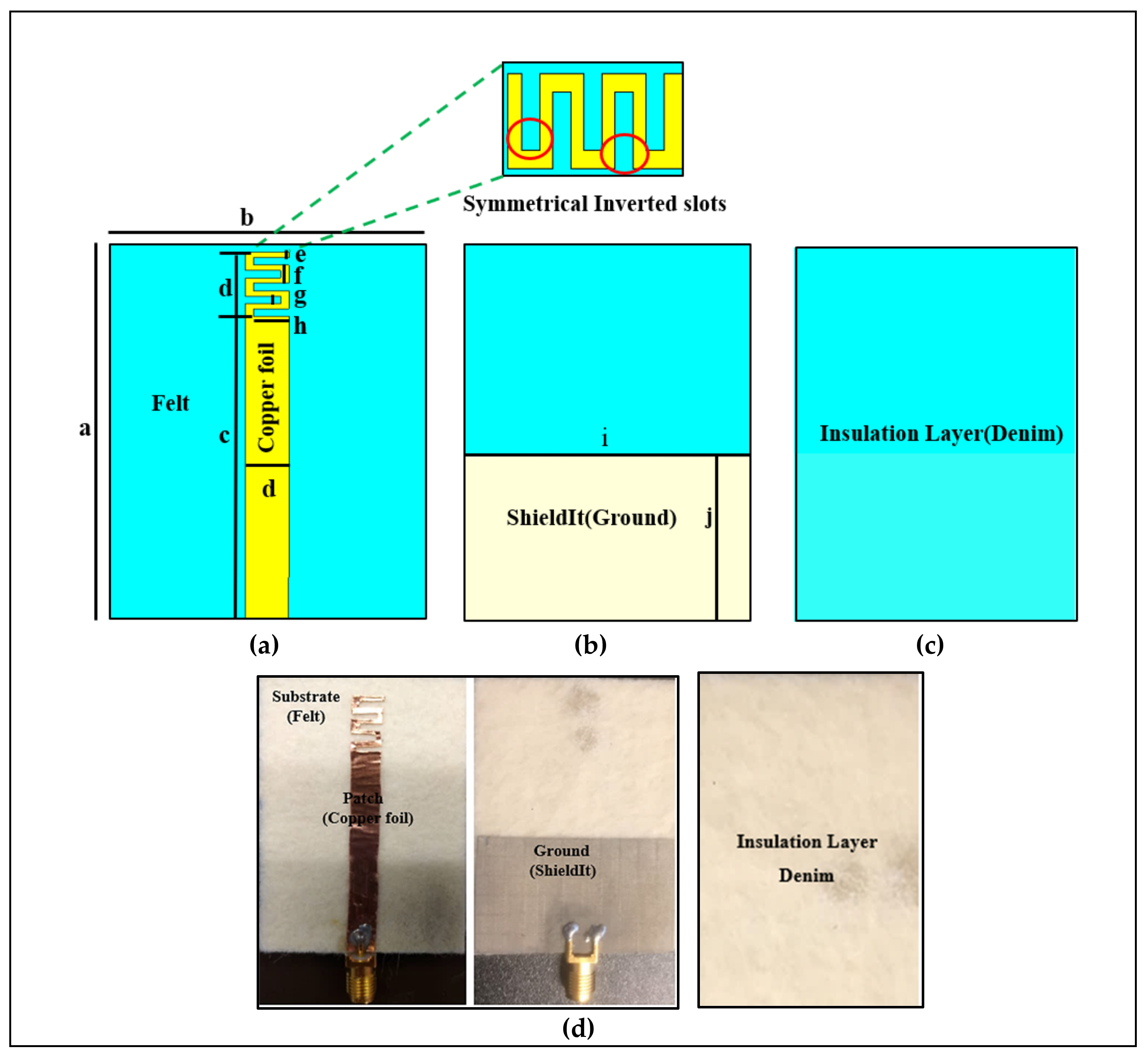
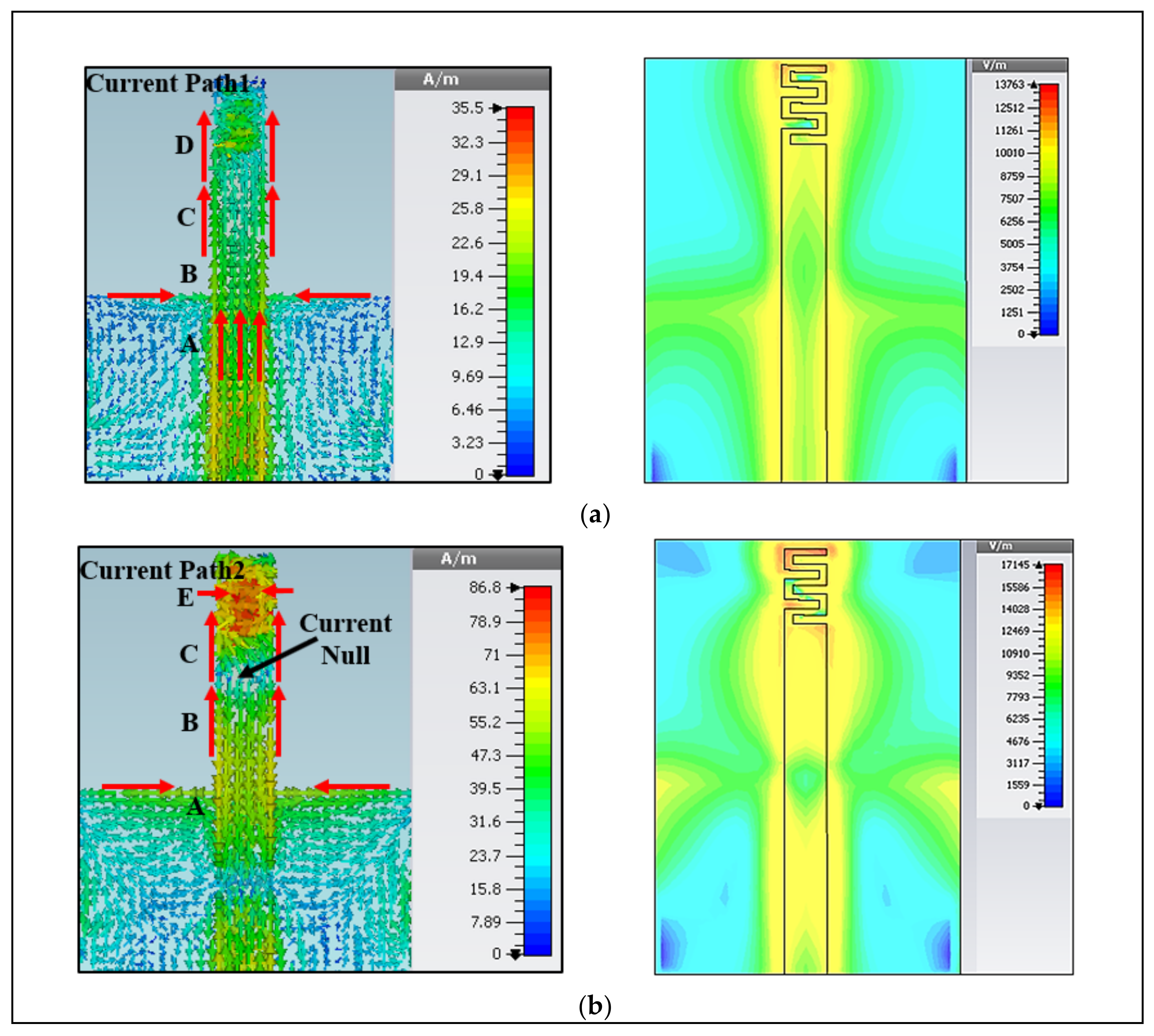
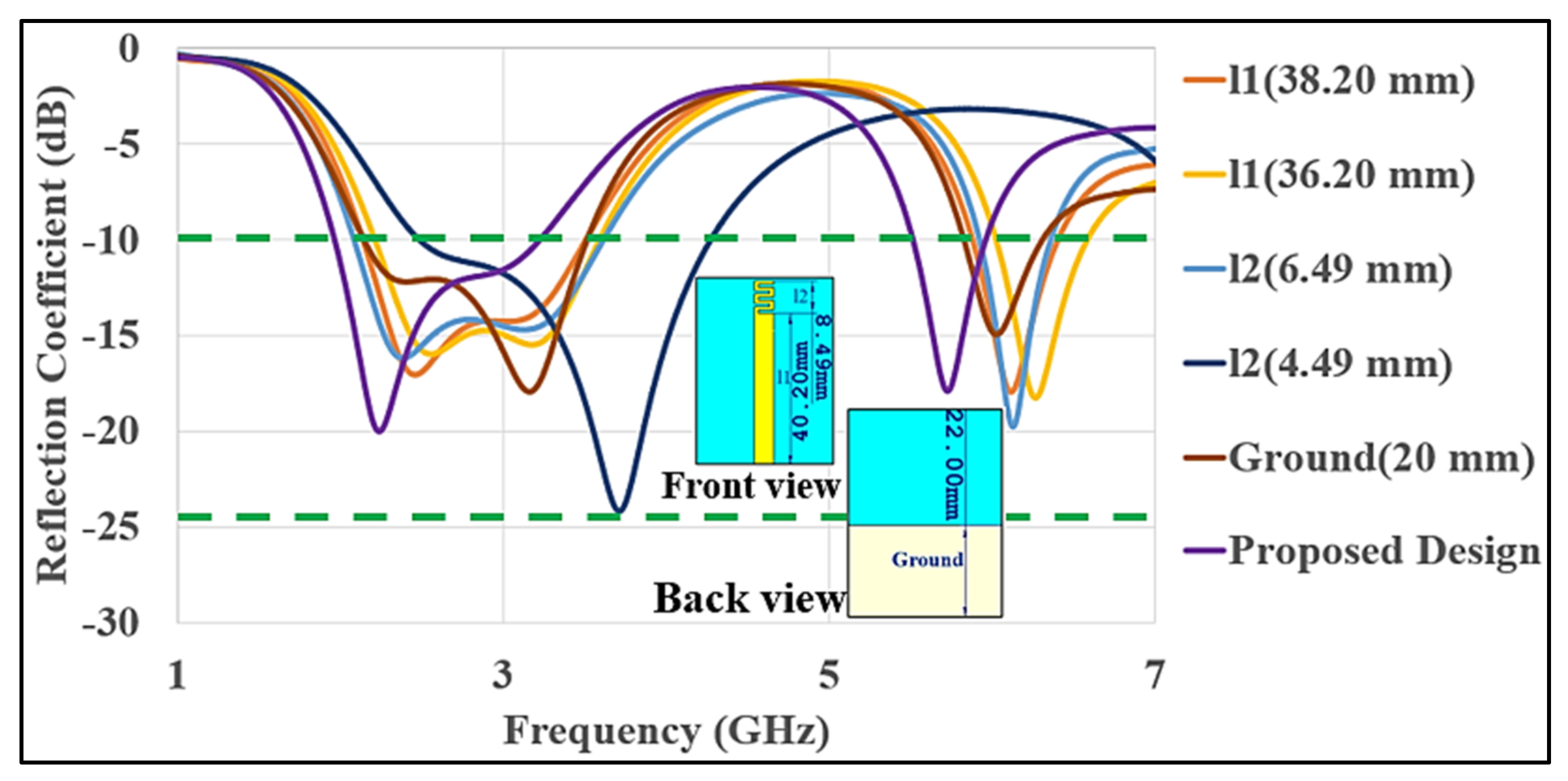
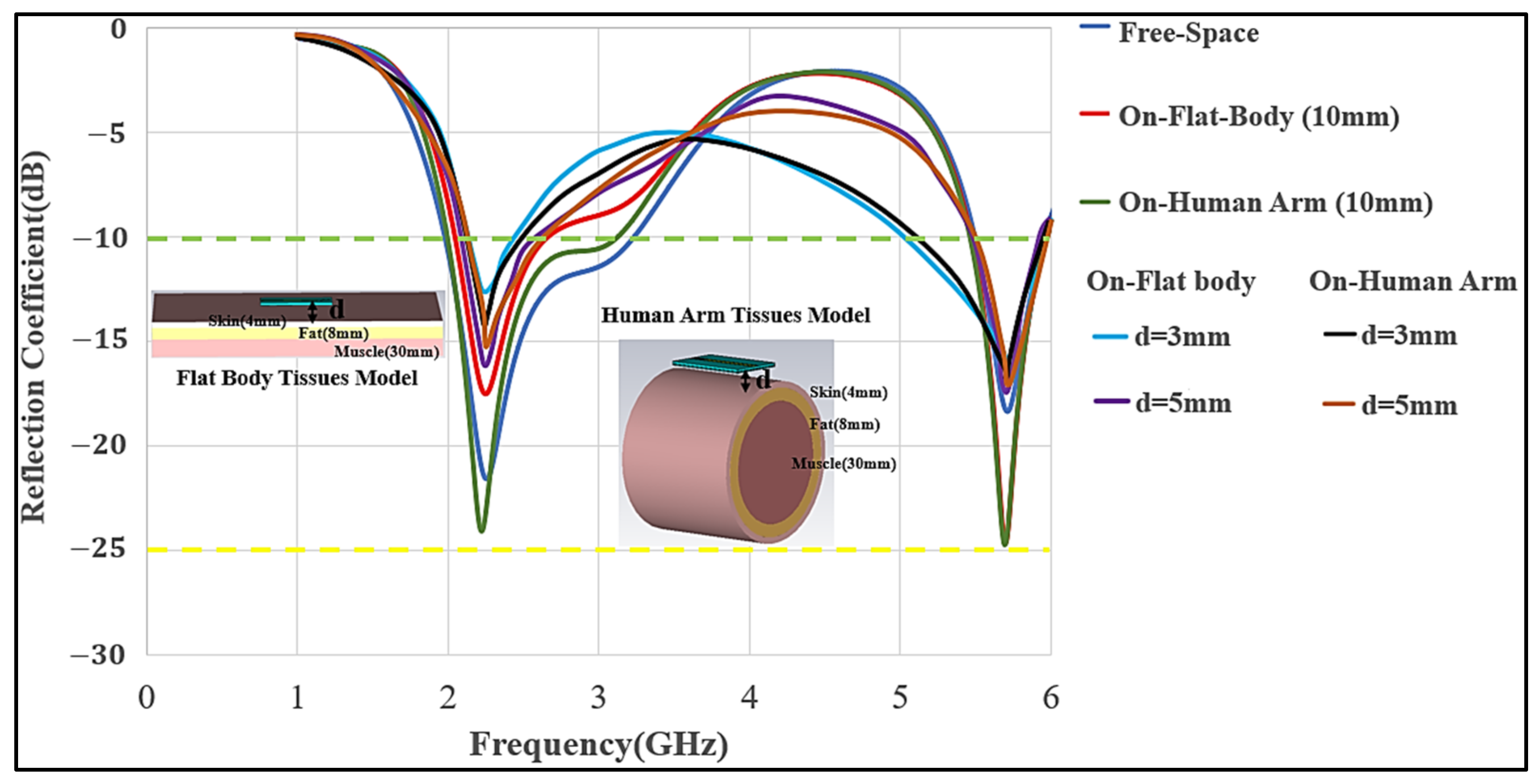
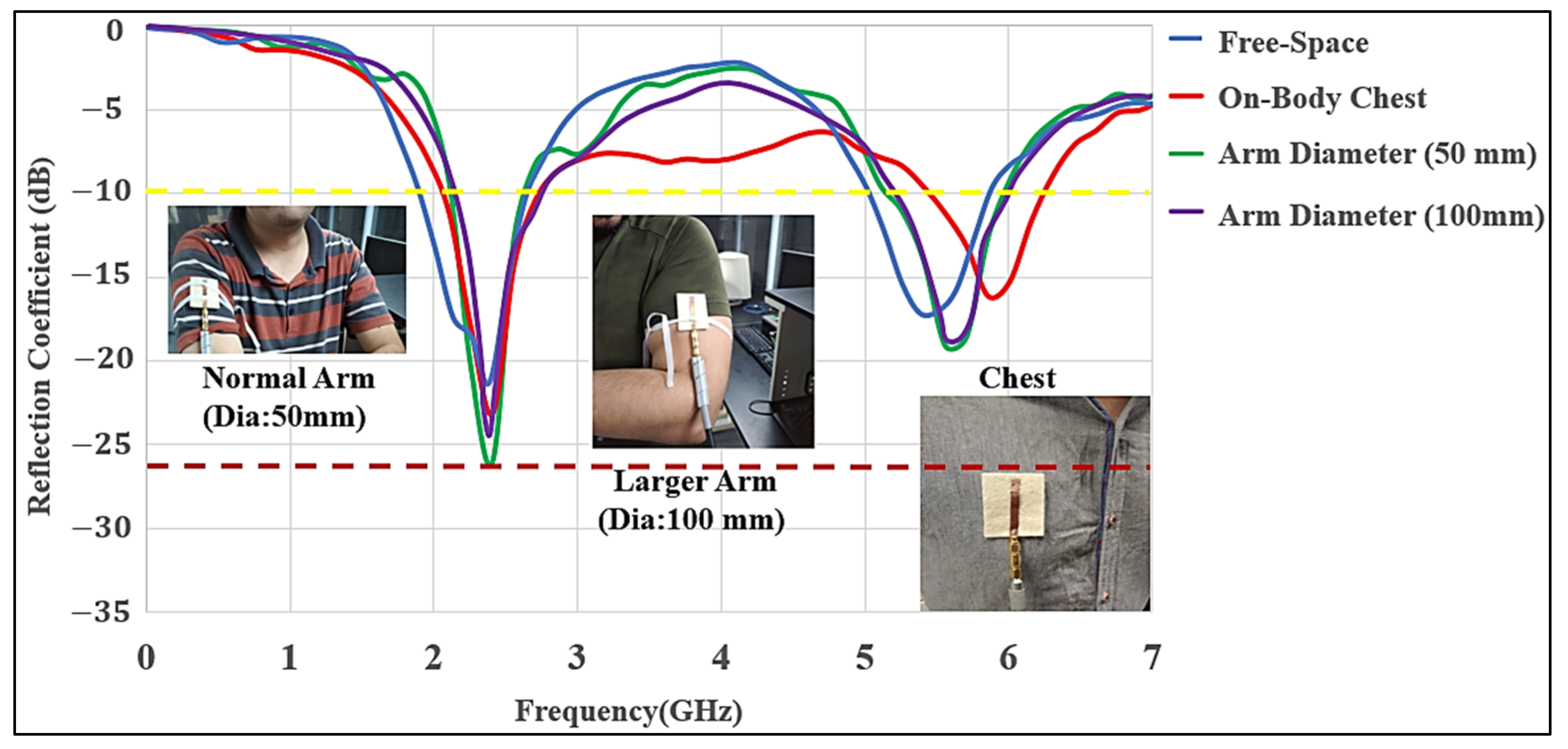
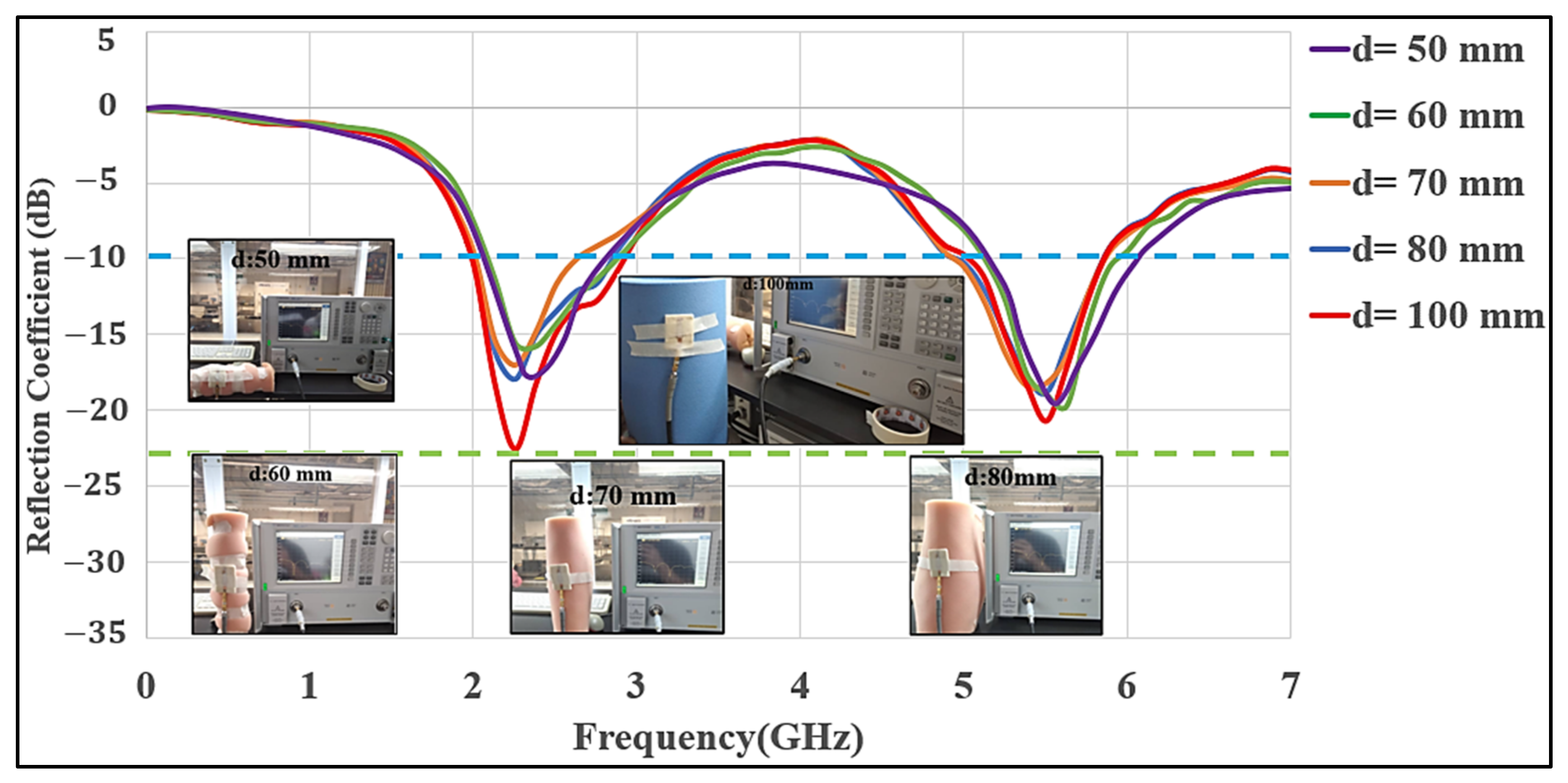
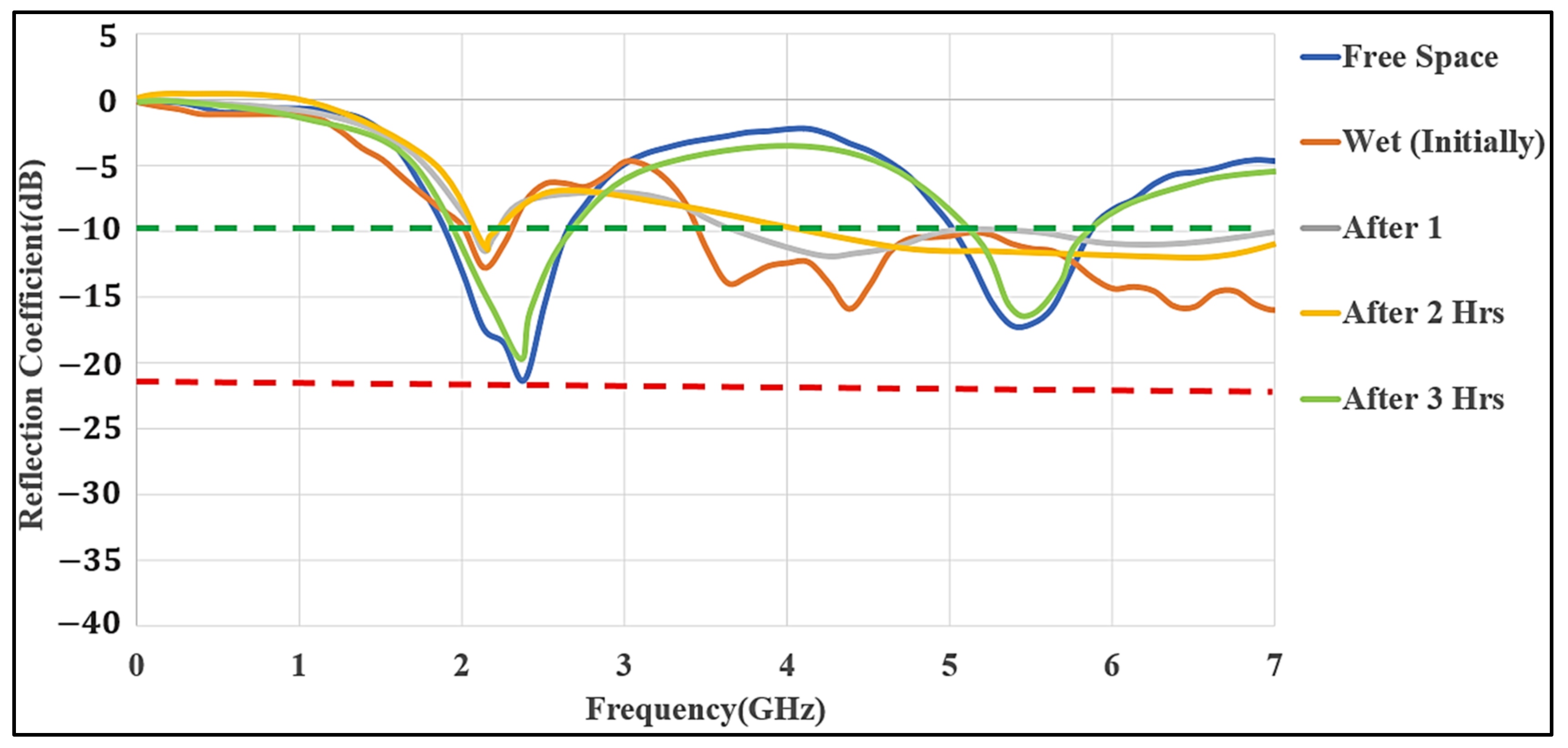
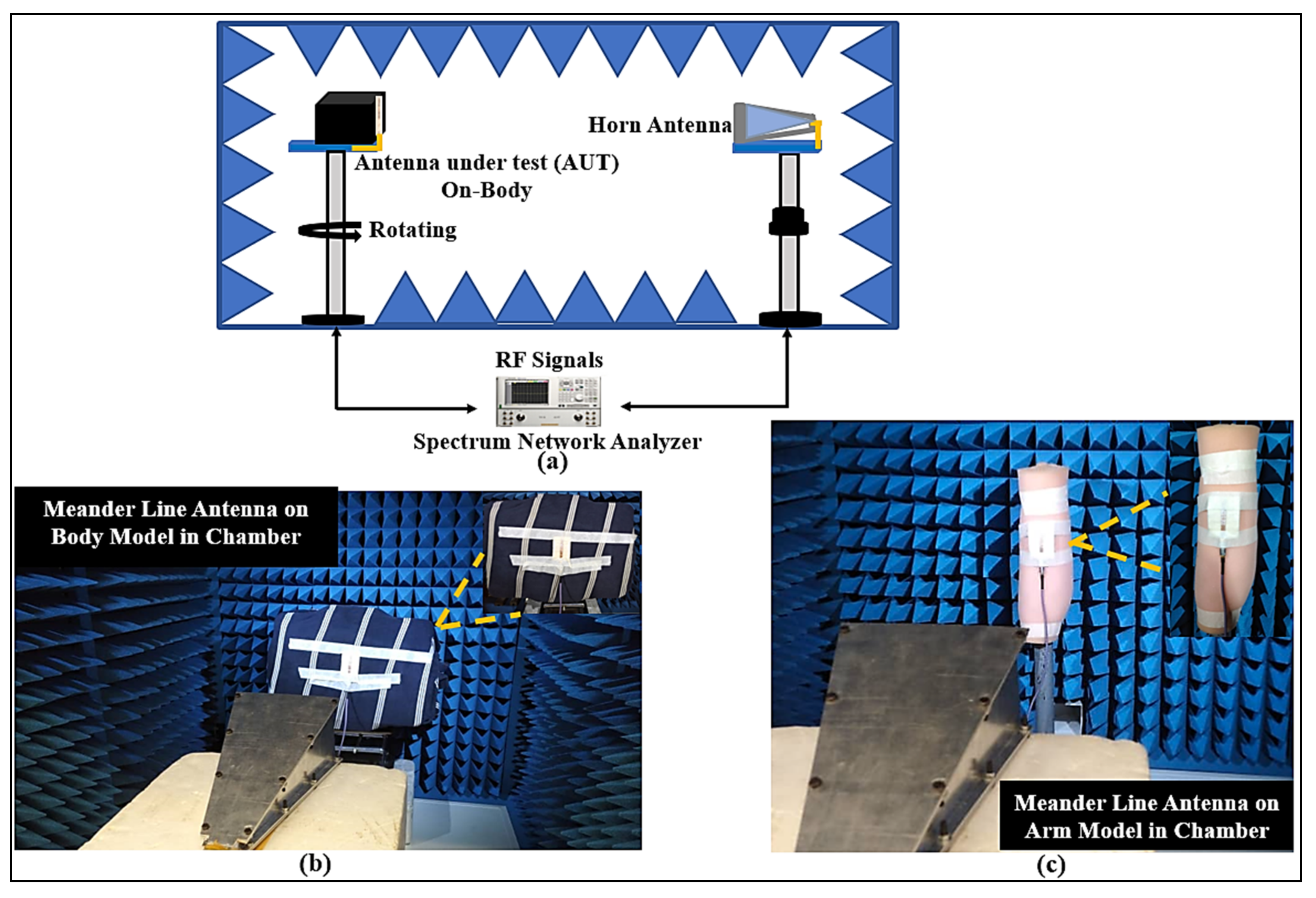
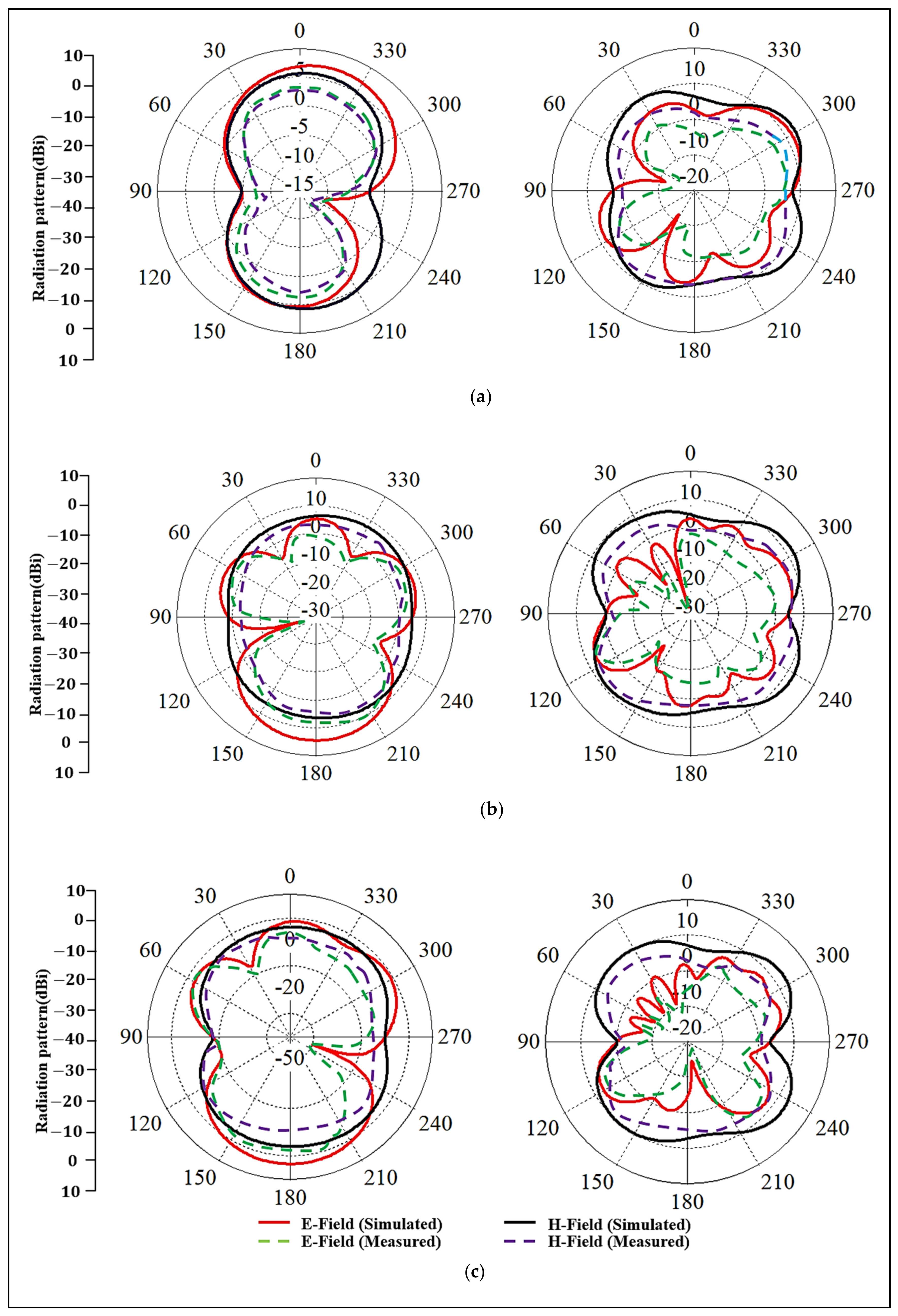
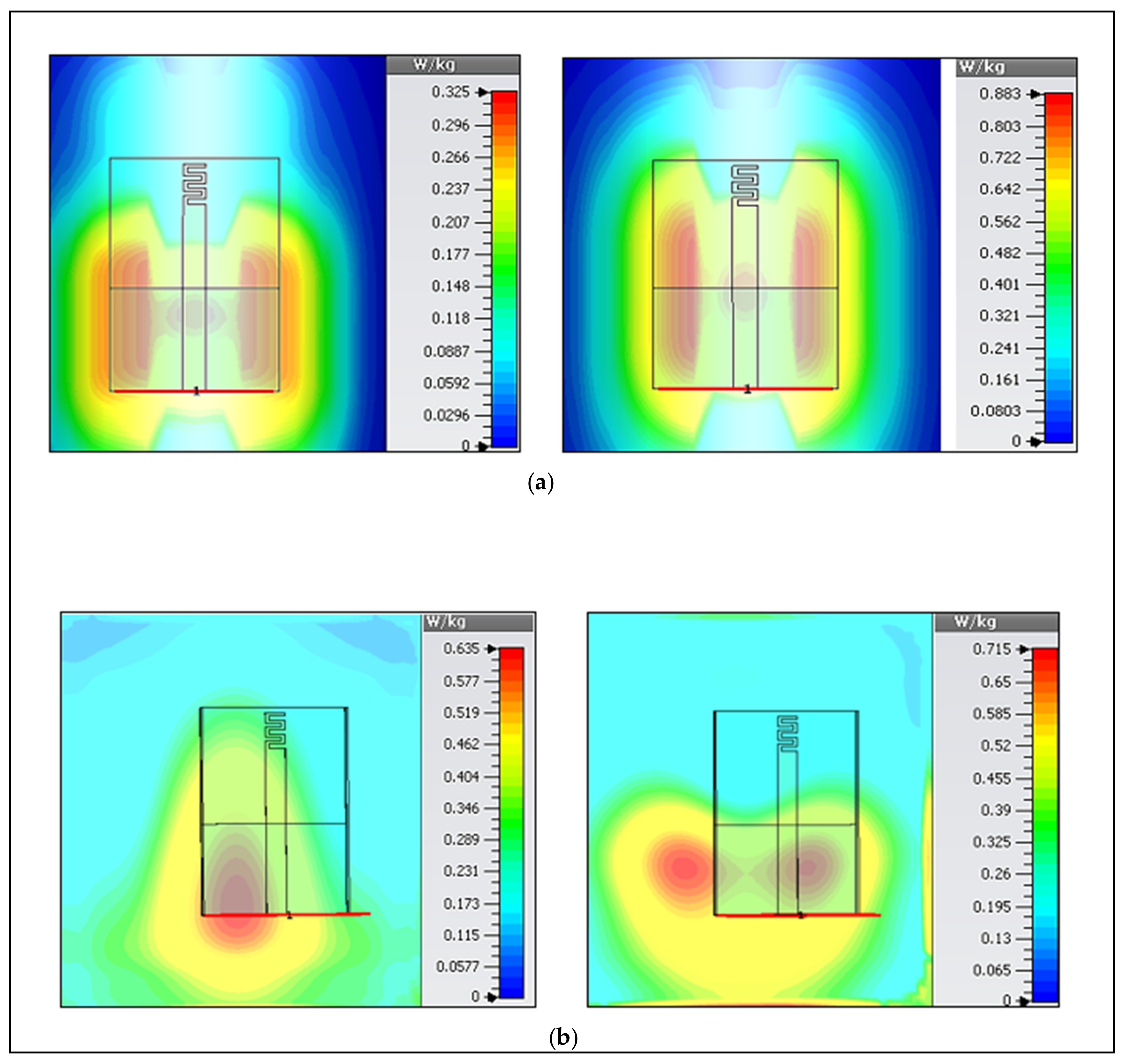
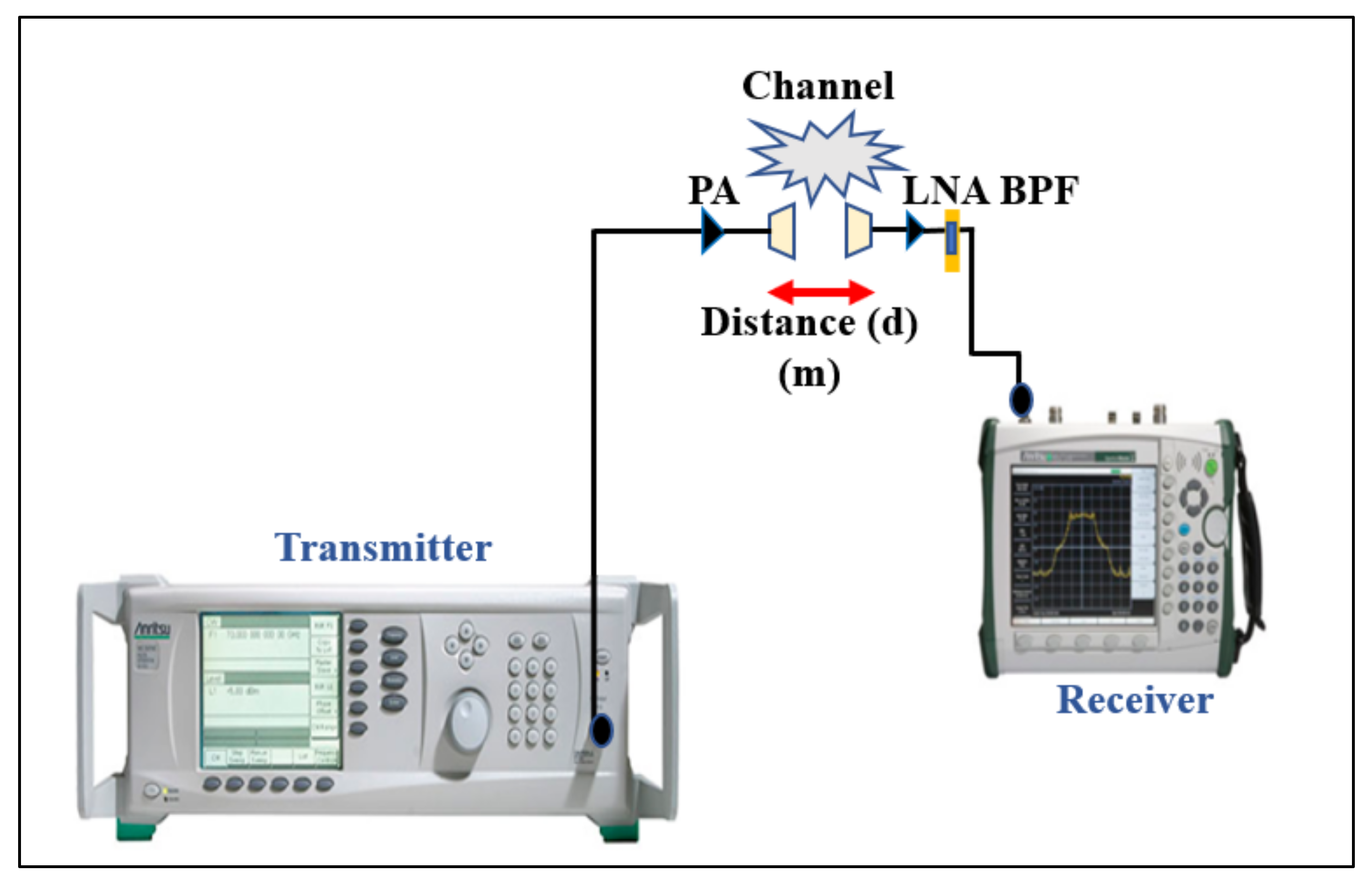
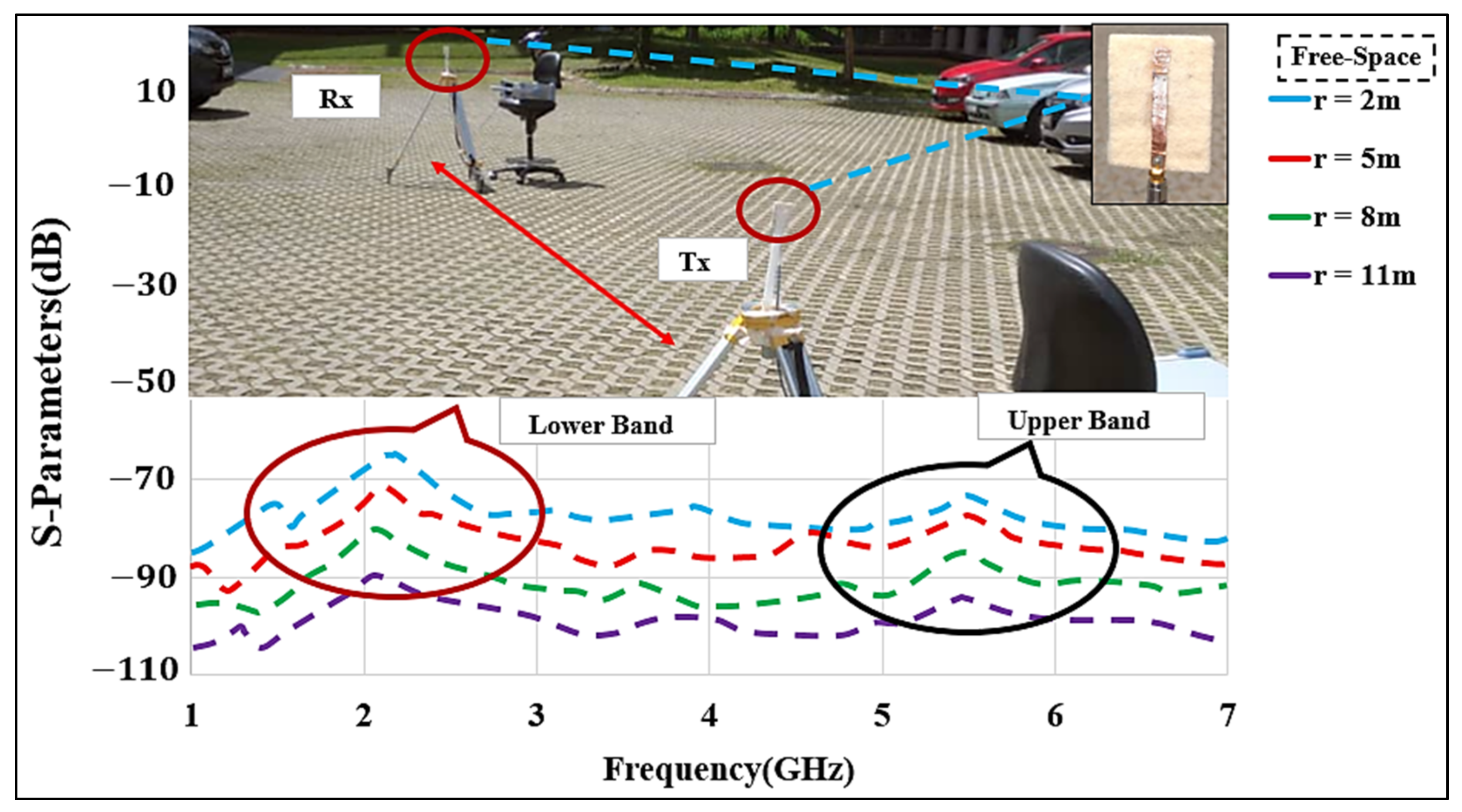
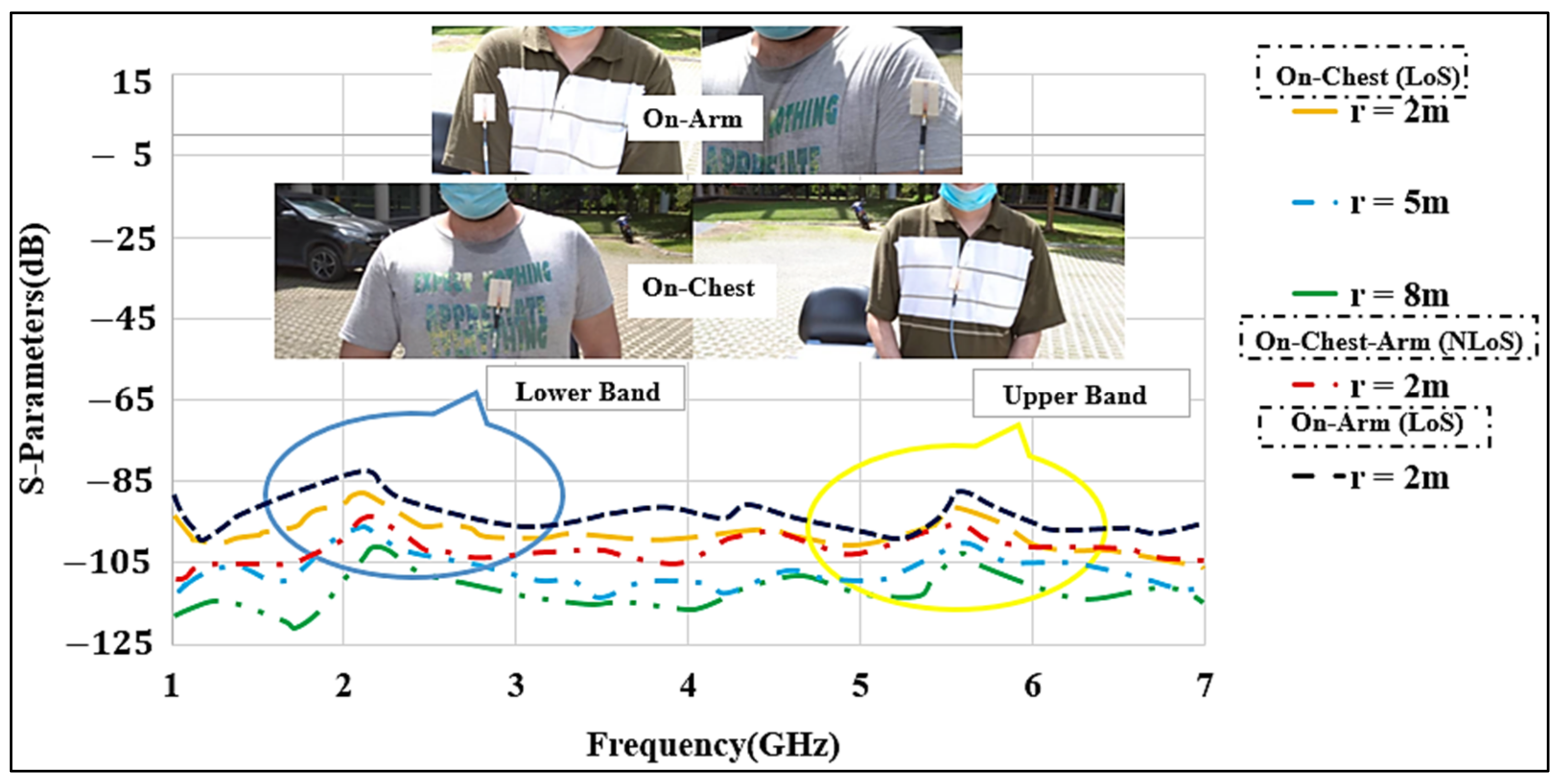
| Ref. | Frequency (MHz/GHz) | Material Substrate/Patch | Size (W × L) (mm2) | Bandwidth (BW) (MHz) | SAR (W/Kg) (1 g/10 g) | Description |
|---|---|---|---|---|---|---|
| [14] | 2.4 Sleeve-Badge Textile Antenna | Fully Textile (Multiple Layers) | 50 × 57 | 140.0 (Free Space) | 0.34 (10 g) | Fully-textile, large size, single band. Not fully tested on the body. |
| [15] | 2.5/4.2/5.5/6.8 Defected Ground Structure (DGS) with Meander line | Copper/FR4 | 40 × 40 | 70/90/350/710 (Free Space) | NA | Multiband, small size, not fully textile. Might be difficult to fabricate. |
| [16] | 2.4/5.2 Metamaterial-loaded Antenna | Felt/ShieldIt | 50 × 50 | 85/200 (Free Space) 130/698 (On-Chest) | 0.2/0.15 (On-Arm) 0.12/0.25 (On-Chest) | Fully textile, dual-band, small size, measured on body, use of metamaterial might make it difficult to fabricate. |
| [17] | 2.5 Monopole Patch antenna | ShieldIt/(Jeans Cotton) | 50 × 60 | 667 (Free-Space) | NA | Fully textile, small size, single band, Not tested on the body. |
| [18] | 2.4 U-slot Patch Antennas | Felt/Copper Foil | 85×70 | 270 (Free space) | NA | Fully flexible, single band, large size, mostly evaluated performance by substrate thickness. |
| [19] | 2.075 to 2.625 Monopole Antenna with FSS Surface | Jeans/Copper Foil | 38 × 50.8 | 550 (Free-Space) | 3.03 (10 g) | Fully flexible, small size, use of frequency selective surface might make it difficult to fabricate, single band, not fully tested on the body and under bending. |
| [20] | 2.4/5.5 Meander Line Slots Antenna | Felt/ShieldIt | 82 × 72 | 132/422 (Free Space) 138/409 (On-Body) | 0.16/0.2 10 g (On-Chest) | Fully textile, dual bands, large size, not fully tested on the body. |
| [21] | 2.4 GHz Microstrip Patch Antennas | Felt/ShieldIt Super | 80 × 100 | 101 Free Space 103/103 (Right-Arm/Chest) | 2.88/0.35 (Upper Right Arm) | Fully flexible, single-band, not fully tested on the body. Used for exposure to the physiological parameters. |
| [22] | 2.45 L-Shaped Patch Antenna | Polyphenylene Ether (PPE)/Copper | 50 × 50 | 120 (On-Body) | 0.6414/1.524 10 g (On-Chest) | Large size, single band. Not flexible, not fully tested on the body. |
| [23] | 2.45 Full Flexible Monopole Antenna | Felt/ShieldIt | 40 × 60 | 720 (Free space) 550 (On-arm) 620 (On chest) | NA | Fully flexible, single-band, large size, not fully tested on the body. |
| This work | 2.20–3.00/5.60–6.00 Meaner Line Monopole Antenna | Substrate (Felt)/Copper Tape/ShieldIt (Patch and Ground) | 37.20 × 50.0 | 1282.4/450.5 (Free space) 688.9/500.9 (On-Chest) 1261.7/524.2 (On-Arm) | On-Chest 1.22/0.75 (1 g), 0.63/0.71 (10 g) On-Arm 1.38/0.692 (1 g), 0.883/0.325 (10 g) | Fully flexible, compact size, dual-band, tested in free-space and on the body with various bending and wet conditions. High stability and high degree of isolation in two bands. |
| Symbols | Dimensions (mm) |
|---|---|
| a | 50.00 |
| b | 37.20 |
| c | 40.20 |
| d | 8.49 |
| e | 0.73 |
| f | 2.38 |
| g | 1.00 |
| h | 14.13 |
| i | 37.20 |
| j | 22.00 |
| Characteristics | Dual-Band Monopole Meander-Line Antenna (Lower/Upper Band) | ||
|---|---|---|---|
| Antenna Parameters | Free-Space | On-Chest | On-Arm |
| Simulated S11 (dB) at the Center Frequency | −21.02/−17.00 | −17.73/−17.00 | −25.20/−25.00 |
| Measured S11 (dB) at the Center Frequency | −21.00/−19.00 | −23.00/−19.00 | −25.00/−20.00 |
| Simulated and Measured Center Frequency (GHz) | 2.2 and 5.6/3.0 and 5.6-6.0 | 2.3 and 5.7/3.0 and 6.0 | 2.2 and 5.7/3.0 and 6.0 |
| Simulated Bandwidth (MHz) | 1282.4 and 450.5 | 688.9 and 500.9 | 1261.7 and 524.2 |
| Measured Bandwidth (MHz) | 1255.0 and 430.2 | 671.9 and 475.2 | 1243.1 and 501.1 |
| Simulated Gain (dBi) | 3.03/4.85 | 3.80/4.67 | 3.00/4.55 |
| Measured Gain (dBi) | 2.76/3.67 | 3.45/4.25 | 2.76/4.15 |
| Simulated Radiation Efficiency (%) | Lower (85.34/83.32) Upper (63.82/50.57) | (54.37/53.40) (54.27/51.39) | (60.0/59.51) (63.73/62.05) |
| Voltage Standing Wave Ratio (VSWR) | 1.22/1.29 | 1.61/1.21 | 1.06/1.19 |
| Radiation Pattern (O/O) | Omnidirectional | Omnidirectional | Omnidirectional |
| Frequency (GHz) | 1-g | 10-g | 1-g | 10-g | SAR Limits (1-g US/10-g EUR) (1.6/2 (W/Kg)) |
| (On-Body) | (On-Arm) | ||||
| 2.2–3.0 | 1.22 | 0.63 | 1.38 | 0.883 | |
| 5.7–6.0 | 0.75 | 0.71 | 0.692 | 0.325 | |
Publisher’s Note: MDPI stays neutral with regard to jurisdictional claims in published maps and institutional affiliations. |
© 2021 by the authors. Licensee MDPI, Basel, Switzerland. This article is an open access article distributed under the terms and conditions of the Creative Commons Attribution (CC BY) license (https://creativecommons.org/licenses/by/4.0/).
Share and Cite
Ali, S.M.; Sovuthy, C.; Noghanian, S.; Ali, Z.; Abbasi, Q.H.; Imran, M.A.; Saeidi, T.; Socheatra, S. Design and Evaluation of a Flexible Dual-Band Meander Line Monopole Antenna for On- and Off-Body Healthcare Applications. Micromachines 2021, 12, 475. https://doi.org/10.3390/mi12050475
Ali SM, Sovuthy C, Noghanian S, Ali Z, Abbasi QH, Imran MA, Saeidi T, Socheatra S. Design and Evaluation of a Flexible Dual-Band Meander Line Monopole Antenna for On- and Off-Body Healthcare Applications. Micromachines. 2021; 12(5):475. https://doi.org/10.3390/mi12050475
Chicago/Turabian StyleAli, Shahid M, Cheab Sovuthy, Sima Noghanian, Zulfiqur Ali, Qammer H. Abbasi, Muhammad A. Imran, Tale Saeidi, and Soeung Socheatra. 2021. "Design and Evaluation of a Flexible Dual-Band Meander Line Monopole Antenna for On- and Off-Body Healthcare Applications" Micromachines 12, no. 5: 475. https://doi.org/10.3390/mi12050475
APA StyleAli, S. M., Sovuthy, C., Noghanian, S., Ali, Z., Abbasi, Q. H., Imran, M. A., Saeidi, T., & Socheatra, S. (2021). Design and Evaluation of a Flexible Dual-Band Meander Line Monopole Antenna for On- and Off-Body Healthcare Applications. Micromachines, 12(5), 475. https://doi.org/10.3390/mi12050475










